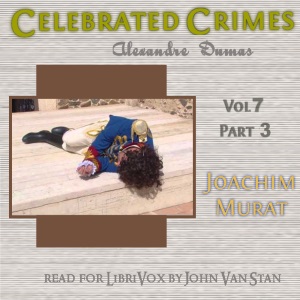Harry Houdini, master illusionist and contortionist, unmasks the various ways that criminals take advantage of their victims. (Summary by Lee Ann Howlett)
21 episodes

Dumas's 'Celebrated Crimes' was not written for children. The novelist has spared no language--has minced no words--to describe the violent scenes of a violent time.In some instances facts appear distorted out of their true perspective, and in others the author makes unwarranted charges. The careful, mature reader, for whom the books are intended, will recognize, and allow for, this fact. (from publisher's note)The first volume comprises the annals of the Borgias and the Cenci. The name of the noted and notorious Florentine family has become a synonym for intrigue and violence, and yet the Borgias have not been without stanch defenders in history.Another famous Italian story is that of the Cenci. The beautiful Beatrice Cenci--celebrated in the painting of Guido, the sixteenth century romance of Guerrazi, and the poetic tragedy of Shelley, not to
mention numerous succeeding works inspired by her hapless fate—will always remain a shadowy figure and one of infinite pathos. (from Introduction)
34 episodes
A Voyage to the South Sea, undertaken by command of His Majesty, for the purpose of conveying the Bread-fruit tree to the West Indies, in His Majesty’s ship The Bounty, commanded by Lieutenant William Bligh. Including an account of the Mutiny on board the said ship, and the subsequent voyage of part of the crew, in the ship’s boat, from Tofoa, one of the Friendly Islands, to Timor, a Dutch settlement in the East Indies. (Summary is the full title)
21 episodes
The Hound of Heaven stalks the death house in pursuit of the soul of a modern Dismas in this true story of a doomed criminal who found God in the solitude of a prison.
The author, Father Raymond, was a Trappist monk from Gethsemani, Kentucky. He was a well known author of such books as "The Man Who Got Even With God", "The Family That Overtook Christ", and many others. (Summary from the dust jacket and Maria Therese)
15 episodes

I met the ex-pickpocket and burglar whose autobiography follows soon after his release from a third term in the penitentiary. For several weeks I was not particularly interested in him. He was full of a desire to publish in the newspapers an exposé of conditions obtaining in two of our state institutions, his motive seeming partly revenge and partly a very genuine feeling that he had come in contact with a systematic crime against humanity. But as I continued to see more of him, and learned much about his life, my interest grew; for I soon perceived that he not only had led a typical thief's life, but was also a man of more than common natural intelligence, with a gift of vigorous expression... I therefore proposed to him to write an autobiography. He took up the idea with eagerness, and through the entire period of our work together, has shown an unwavering interest in the book and very decided acumen and common sense. The method employed in composing the volume was that, practically, of the interview. From the middle of March to the first of July we met nearly every afternoon, and many evenings, at a little German café on the East Side. There, I took voluminous notes, often asking questions, but taking down as literally as possible his story in his own words; to such a degree is this true, that the following narrative is an authentic account of his life, with occasional descriptions and character-sketches of his friends of the Under World. Even without my explicit assurance, the autobiography bears sufficient internal evidence of the fact that, essentially, it is a thief's own story. - Summary by Hutchins Hapgood (from the Preface)
16 episodes
Dumas's 'Celebrated Crimes' was not written for children. The novelist has spared no language--has minced no words--to describe the violent scenes of a violent time.In some instances facts appear distorted out of their true perspective, and in others the author makes unwarranted charges. The careful, mature reader, for whom the books are intended, will recognize, and allow for, this fact. Summary from publishers note.
15 episodes
Published by Beaver Publishing Company, Toronto, and subtitled "Full and authentic account of the murder by Henry Wainwright of his mistress, Harriet Lane, and an extended account of the Whitechapel murders by the infamous Jack the Ripper."
4 episodes
This is the dramatic story of Urbain Grandier, a catholic priest, who had a reputation to rival that of Casanova, which ultimately led to his destruction. He was accused of witchcraft after a series of accusations from nuns of a nearby convent, who claimed that Grandier has sent several demons upon them. The case is very well documented, and the original documents of the alleged pact, written in backwards Latin and signed by all participating demons, are still preserved. The case continues to inspire art and sciences, leading to assessments of the events in light of modern sociology, psychology, and legal sciences. Alexandre Dumas' version of the events is presented here. - Summary by Carolin
14 episodes
Good against evil; right versus wrong; the judicial system against the criminal world. The struggle is as old as mankind. Sometimes the lines are blurred as the 'good' punish the 'bad' - the warriors against crime have resorted not only to killing wrong-doers, but additionally subjecting them to "starvation or the withholding of fluid, by drowning, stoning, impaling or by exposing the wretched victims to the stings of insects or snakes." Newgate Prison was one of the most famous - or infamous - prisons in England from the middle ages until the nineteenth century. Griffiths, a prison administrator, takes us inside where we discover "man's inhumanity to man". Volume 2 picks up where Volume 1 left off. - Summary by Lynne Thompson
22 episodes
In 1912, $25,000 was stolen during a bank transfer in New York City in broad daylight. In what may appear astonishing in today's world, the transfer occurred in a New York City taxicab.
This factual account brings true crime of the early twentieth century to life. The various methods used by the detectives and police in their attempts to solve the mystery behind the robbery, and hopefully bring the thieves to justice, makes for great reading, particularly when one considers the fact that the accounts occurred over a century ago, and are quite authentic. Although the police now have higher technological advantages than was available over a century ago, the reader may find that many general techniques haven't changed all that much over the years. The characters involved with this true caper prove ingenious on both sides.
( Roger Melin)
10 episodes

John Parsons Cook was a 28 year old bachelor, from a good family but not in robust health. He studied to become a lawyer, but instead of following that career, turned to raising race horses. In November 1855, during a visit to the Shrewsbury races, he was taken violently ill. He was attended by the 80 year old local doctor Dr. Bamford, and Cook's friend and sometimes partner, Dr. Palmer.
William Palmer was a physician and surgeon, a widower and father. His appearance instilled confidence and invited trust. But were appearances deceptive? Was he, in fact, a cool, calculating and vicious serial murderer, who used his knowledge and skill for evil ends, to escape the effects of an addiction that was destroying his life? There are numerous references to this case in fiction, by Dickens, Sayers, Hitchcock and others; and the familiar salutation "What's your poison?" is believed to date from the events of this case. This is true courtroom drama, more gripping than fiction and it will have you guessing until the end.( Lynne Thompson)
24 episodes
This is the fourth volume of Alexandre Dumas' studies of celebrated crimes and their perpetrators. This volume is concerned with the story of Karl Ludwig Sand, who stabbed August von Kotzebue to death in 1819. August von Kotzebue had been a prominent dramatist, a student of Musäus, whose royalist and conservative writings ultimately led to his assassination by a member of a revolutionary liberal Burschenschaft. - Summary by Carolin
4 episodes
This story details the many crimes (attempted rape, assault, filicide, etc.) surrounding a significant historical confrontation between a fisherman from the island of Nisida, named Gabriel, and the Italian Prince of Brancaleone. Dumas notes that "the details of this case are recorded in the archives of the Criminal Court at Naples." - Summary by jvanstan
3 episodes
This story chronicles the crimes of Antoine-Francois Desrues (also called "Derues") from his childhood to his execution. Desrues constructed the veneer of a virtuous reputation that hid his ever-increasing deviancy from society. Eventually, his lust for fame and fortune (especially the latter) crumbled his virtuous veneer, revealing the startling extent of his crimes, and condemning him to justice by the executioner's hand. - Summary by jvanstan
7 episodes
Dumas, with the assistance of several friends, compiled Celebrated Crimes, an eight-volume collection of essays on famous criminals and crimes from European history. . This volume tells the story of the infamous prison on Nisida a small island near Naples. - Summary by Michele Eaton
6 episodes
Dumas chronicles the court intrigues that led to the execution of Marie La Roux Constantin. La dame Constantin was known by French nobility in the 17th century as the “midwife to the Queen’s daughters.” This title was, in reality, a dark jest as her business was providing dangerous (often maternally fatal) abortions to women ensnared in the machinations of powerful noblemen. This case also highlights how strongly gender inequalities permeated the justice system of this time as reviews by historians, like Dr. Leigh Whaley, found La Constantin was condemned “without any tangible evidence against her.” - Summary by jvanstan
9 episodes
The celebrated crimes committed during the life of Joan (Joanna I) of Naples span from personal misdeeds (adulteries and mariticide) to regional warfare (like the 1345 War in the Piedmont), and ultimately unraveled her father’s legacy (King Robert the Wise). Dumas projects her story through a deathly lens: beginning with the passing of King Robert the Wise, winding through the untimely demise of nobles, soldiers, and children, then ending at Joan’s own assassination. - Summary by jvanstan
8 episodes
Dumas, with the assistance of several friends, compiled Celebrated Crimes, an eight-volume collection of essays on famous criminals and crimes from European history. Includes Vaninka and The Marquise De Ganges. - Summary by Michele Eaton
22 episodes
Martin Guerre was a French peasant that, during a long absence, was famously impersonated in the 16th century. Although the real Martin Guerre is suspected of no serious crimes, his imposter, Arnaud du Tilh, engaged in fraud and adultery while pursuing false claims to the Guerre inheritance. Dumas later incorporates this celebrated crime into his novel “The Two Dianas.” - Summary by jvanstan
5 episodes
A series of articles by the New York World newspaper's special correspondent covering the assassination of Abraham Lincoln, its background and subsequent events. It should be noted that some statements in this contemporaneous account have since been shown to be inaccurate. Summary by Delmar H. Dolbier
14 episodes
Ali Tepeleni, Pacha of Janina, rose to power during the early 1800s in one of the Ottoman Empire’s most unruly territories (Albania). His ferocious imposition of will was limitless, earning him the sobriquet of “the Lion of Janina.” As the mauling and murder of innocents sustains the lion, so did it sustain Ali Pacha’s rule. Thus, the range of celebrated crimes that Dumas describes in this essay are as vast as Ali Pacha’s ambition – an ambition rooted in his mother’s callous advice that “success justified everything, and everything is permissible to him who has the power to do it.” - Summary by jvanstan
11 episodes
Amidst the political winds from Napoleon’s downfall, this tale turns our attention to the flight of a former French marshal and King of Naples, Joachim Murat. Murat, unhappy with the deal he made to obtain pardon from the Austrian Emperor, takes a life-ending resolution to retake his crown rather than live in peaceful obscurity. - Summary by jvanstan
3 episodes
The story of Vaninka, generally regarded as the most fictionalized of Dumas’ Celebrated Crimes series, occurs during the short and eccentric rule of Emperor Paul I of Russia. Vaninka is a general’s daughter whose love for one of her father’s officers leads to tragic death, savage crimes and perversions of justice. - Summary by jvanstan
4 episodes

The story of how Lizzie Borden supposedly murdered her parents has passed into American folklore, partly thanks to the albeit inaccurate playground rhyme, "Lizzie Borden took an axe, and gave her mother 40 whacks. When she saw what she had done, she gave her father 41." Here we have the 'true' story, as reported by the local police reporter who attended the trial and lived only streets away from the Borden home with his young wife. After the trial, Porter 'disappeared' and it was widely speculated he had either been murdered or bribed to disappear in order to suppress the book. His reappearance some time later put paid to the first theory. After his death at age 39 from tuberculosis, a new theory emerged, that he had been away for treatment while keeping his illness secret. Meanwhile, the trial itself was noteworthy for several reasons: it was one of the first to be followed by nationwide press, providing a template for today's tabloid and cable coverage of major trials; it also had some distinguished personnel: one of the prosecutors, Frank Moody, later became the attorney general of the United States and was appointed to the Supreme Court by President Theodore Roosevelt; and Borden’s defense attorney, George Robinson, was the former governor of Massachusetts. The appearance of Professor Wood of Harvard University was an early use of an expert witness at trial.
36 episodes
The Library of Romance is a series of books concerning the romance of scientific facts, be it biology, chemistry, history, or politics. This volume is one of history, concerning an account of the known facts of piracy, starting with the Vikings, and arching in history and geography toward an account of piracy in Chinese waters at around the time of publication of this volume (1914). - Summary by Carolin
27 episodes
Hitherto unpublished facts connected with some of Mr. Furlong's greatest cases—Other interesting incidents of his long and strenuous career which really began on September 14, 1862, when he was detailed from his company, (Co. G., 1st Pennsylvania Rifles, better known as the Pennsylvania Bucktails) for special service. - Summary from the Preface
36 episodes
''An authentic and thrilling history of the noted outlaws Jesse and Frank James and their bands of highwaymen.compiled from reliable sources and containing the latest facts in regard to these desperate freebooters.'' (from the author's sub-title) The James brothers emerged from the Confederate guerrillas to become notorious outlaws of the American west rising to legendary status. J.W. Buel chronicles their path of robbery and murder across the West in short vignettes.
- Summary by Larry Wilson
41 episodes


























